Can You Lease a Power Wheelchair Instead of Buying?
Leasing may be a practical alternative to purchasing a power wheelchair, especially if you're looking for flexibility. Learn the key differences between leasing and financing, what each option involves, and how to choose the best fit for your mobility and budget needs.

What Are the Key Differences Between Leasing and Financing a Power Wheelchair?
Understanding the differences between leasing and financing a power wheelchair helps you make an informed decision about your mobility investment. When you finance a wheelchair, you’re borrowing money to purchase the equipment outright, building equity with each payment until you own it completely. The wheelchair becomes your property, and you can modify, sell, or keep it indefinitely.
Leasing operates more like renting a car. You pay monthly fees for the right to use the wheelchair during the lease term, typically 12 to 36 months. At the end of the lease, you can return the wheelchair, purchase it for a predetermined residual value, or lease a newer model. Most lease agreements include maintenance and repair services, reducing unexpected costs during the rental period.
What Are the Pros and Cons of Leasing a Mobility Device?
Leasing a power wheelchair offers several advantages that make it attractive for many users. Lower monthly payments compared to financing make premium wheelchairs more accessible on tight budgets. Most lease agreements include comprehensive maintenance, repairs, and technical support, eliminating concerns about costly breakdowns. You can upgrade to newer models with advanced features as technology improves, ensuring access to the latest mobility innovations.
However, leasing also has drawbacks to consider. Over time, lease payments may exceed the wheelchair’s purchase price, making it more expensive long-term. You never build equity or ownership, and excessive wear or damage may result in additional fees. Early termination can be costly, and customization options are typically limited since you don’t own the equipment.
When Does Leasing a Power Wheelchair Make Financial Sense?
Leasing a power wheelchair makes financial sense in several specific situations. If you need a wheelchair temporarily due to recovery from surgery or injury, leasing avoids the high cost of purchasing equipment you won’t need long-term. People with progressive conditions whose mobility needs may change significantly benefit from the flexibility to upgrade without selling existing equipment.
Budget-conscious individuals who need premium features immediately can access high-end wheelchairs through leasing when purchasing isn’t financially feasible. Those who prefer predictable monthly expenses with included maintenance find leasing eliminates unexpected repair costs. Additionally, if you’re uncertain about specific features or brands, leasing allows you to test different options before committing to a purchase.
How Can You Apply for a Power Wheelchair Lease Program?
Applying for a power wheelchair lease program typically begins with consulting a mobility specialist or durable medical equipment provider in your area. Many providers offer both sales and leasing options, allowing you to compare terms directly. You’ll need medical documentation from your healthcare provider confirming your need for a power wheelchair, similar to requirements for purchasing.
The application process usually involves completing a credit application, as lease companies evaluate your ability to make monthly payments. Some providers offer lease-to-own programs that don’t require perfect credit, making wheelchairs accessible to more people. Review lease terms carefully, including monthly payments, lease duration, maintenance coverage, upgrade options, and end-of-lease choices before signing any agreement.
Is Renting a Power Wheelchair Better Than Buying One?
Whether renting a power wheelchair is better than buying depends on your specific circumstances and long-term needs. Short-term rental makes excellent financial sense for temporary needs, travel, or trying different wheelchair types before purchasing. The flexibility to return equipment without long-term commitment appeals to many users, especially when medical conditions or mobility needs remain uncertain.
However, purchasing becomes more cost-effective for permanent, long-term use. Ownership allows complete customization, modification, and the freedom to use the wheelchair without restrictions. Many insurance plans cover wheelchair purchases more comprehensively than rentals, potentially reducing your out-of-pocket expenses significantly. Consider your expected usage duration, budget constraints, insurance coverage, and personal preferences when making this decision.
| Provider Type | Monthly Lease Cost | Purchase Option | Maintenance Included |
|---|---|---|---|
| National DME Companies | $150-$400 | Yes, residual value | Full coverage |
| Local Mobility Dealers | $125-$350 | Often available | Varies by contract |
| Rent-to-Own Programs | $200-$500 | Built into payments | Basic coverage |
| Short-term Rental | $300-$800 | Rarely offered | Emergency only |
Prices, rates, or cost estimates mentioned in this article are based on the latest available information but may change over time. Independent research is advised before making financial decisions.
Making the Right Choice for Your Mobility Needs
Choosing between leasing and buying a power wheelchair requires careful consideration of your medical needs, financial situation, and long-term mobility goals. Leasing provides immediate access to quality equipment with lower upfront costs and included maintenance, making it ideal for temporary needs or budget-conscious users. However, purchasing offers better long-term value for permanent users who want complete ownership and customization options. Consult with mobility specialists, review your insurance coverage, and evaluate multiple providers to find the arrangement that best serves your specific situation and ensures reliable access to the mobility equipment you need.




